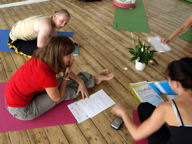Classes in Yoga Techniques for Teachers and Parents
TEACHERS HANDBOOK – AVAILABLE NOW TO PURCHASE!
 We have now included YOGA TECHNIQUE CLASSES FOR TEACHERS &/OR PARENTS into our services.
We have now included YOGA TECHNIQUE CLASSES FOR TEACHERS &/OR PARENTS into our services.
These classes/workshops are designed to educate the teacher/parent on various yoga techniques that will be useful to use in the classroom. These techniques include some yoga postures, meditiations/visualisations and breathing techiniques.
*3% of all course costs are donated to Charities—‘NSPCC’ www.nspcc.org.uk and ‘Save the Children’ www.savethechildren.org.uk/*
BECAUSE THIS TRAINING CAN BE ADAPTED TO SUIT YOUR REQUIREMENTS, PLEASE CONTACT YOGAKIDZ IN THE FIRST INSTANCE TO ARRANGE DATES/TIMES/COSTS ETC.
Classes are either an hour taught over 6 weeks, half day workshops or full day workshops. All teachers/parents will have the experience of doing the yoga techniques before teaching/using them in the classroom/at home. NO PREVIOUS EXPERIENCE IS REQUIRED
By using simple breathing techniques, students experience a decrease in hyperactivity, reduce anxiety at test-time, and regain focus. Non-threatening postures offer a break from classroom routines and re-energize students and the teacher. A teacher can use a variety of yoga techniques when the time requires it.
PLEASE WATCH THIS SHORT VIDEO ON WHY MEDITATION/YOGA IS SO VALUABLE IN SCHOOLS:
Why do students enjoy these classroom activities?
The unfamiliarity and total child involvement may be the reasons. After the stimulation of lunchtime in the roar of the cafeteria, students frequently have difficulty regaining their focus. Instead of repeating an ineffective mantra, “Sit down and get quiet!” I might try this approach: “Pupils, please remain standing, your spine straight, next to your desk. Bend your right leg at the knee and place your foot against your thigh. Now practice your balance by raising your arms into the air. Now we’re each a graceful tree (Vrkasana) with our branches swaying in the breeze.” After repeating the balancing pose on the right leg, the students’ classroom poise has returned and we’re ready to work.
Here are a few tried and proven academic and behavioral management techniques. Keep in mind that any of these may be changed to suit the pupils’ age, and skill level.
A brainstorming activity that’s been successfully used with all class levels is a guided meditation. The classroom purpose is to provide an introductory means of getting in touch with sensory images in order to add details to student writing. Through this technique, students can mentally see, hear, touch, and smell the details of a setting. With classroom light off, you can instruct pupils to sit with their backs upright, hands softly folded in their laps. After allowing a few moments for the breathing to calm, You can ask pupils to mentally go to their favorite locale in nature…the beach, the mountains, a creek side. “Look around. Make a mental note of everything you see. The sky, the waves, the trees. Next listen mentally to the sounds that are part of your environment. Seagulls cawing, waves crashing, branches crackling underfoot. Now let’s get in touch with surroundings. Feel the warmth of the sun or the chill in the air on your skin. Can you touch the softness of a flower’s petal? Or the ridges of a seashell? Now turn your sensory awareness to the smells in your environment. Do you notice the ocean salt smell or perhaps the fragrance of new-mown hay? Kneel down to take in the delicate aroma of a wildflower.” As we unhurriedly go through each sense, I allow moments of silence to pass to give pupils the opportunity to explore their mental surroundings. To take more time would invite the mind to wander.
After spending 10 – 15 minutes on this activity, the pupils are relaxed, filled with sensory images, and ready to put their descriptive ideas on paper. I next instruct the students to descriptively write about the place they mentally visited, focusing on the sensory details. My favorite feedback after this activity is, “When can we do this again?”
To settle a class after a fire drill or other disruptive event, I might ask students to stand in mountain pose (Tadasana) with feet around 8 inches apart, hands comfortably at the side of the legs, and a soft gaze forward – focusing on slowing down the breath. A minute of this pose slows and calms the heartbeat and helps bring the mind into focus.
Through practicing yoga I’ve experienced an increase in flexibility and endurance, a calmness of mind and spirit, and sense of harmony with my universe. Yoga in the classroom becomes another teachers tool and a way of sharing the benefits.
(information by Sandra Bell)
All classes and workshops include basic postural work, meditations, breathing techniques. An emphasis on using yoga techniques positively is extremely important.

